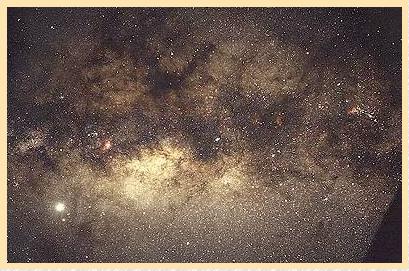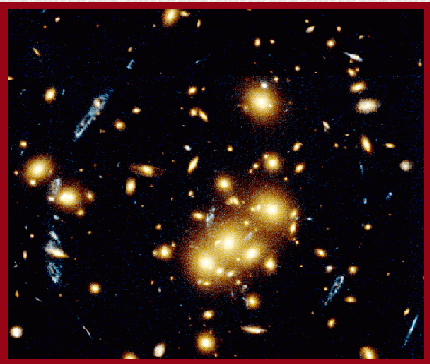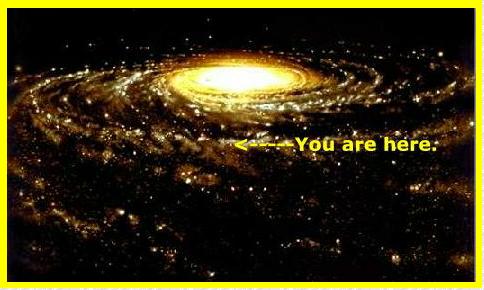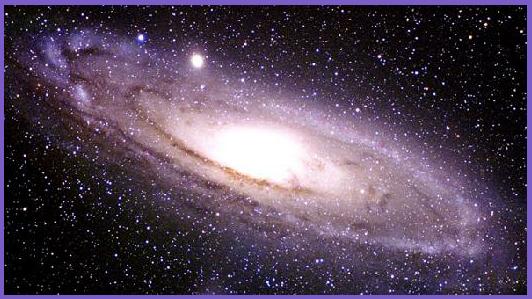 Lesson 1:
Lesson 1:
 Ecology of the System
Ecology of the System
|
 1.8
1.8
 The Discovery of the Galaxy
The Discovery of the Galaxy
and the Vastness of Space

|

Figure 1.8.1 The Milky Way
|
There are two privileged lines in the sky. One is the familiar ecliptic,
the path traveled by the Sun. It is the image of our orbit around the
central star, as seen from the Earth, against the stars. The Moon
travels not far from this path and it even occasionally eclipses the
Sun, and sometimes the Earth's shadow falls on the Moon. Likewise, the
main planets stay fairly close to this line in the sky. We see that the
orbits of most of the planets tend to lie in the same plane and this plane is
close to that of Earth's orbit.
The other privileged line is the one centered on the Milky Way. While
the name of the first line ("ecliptic") suggests a function (the line
where eclipses occur), the name "Milky Way" suggests nothing useful
other than general milky appearance (the name is derived from a Greek
fairy tale involving a goddess and her milk). After telescopes became
commonplace, following the efforts of Galileo, it was soon realized that
the Milky Way is an unusually dense collection of stars, all lined up.
Where it is dark, it was found, dust clouds block the light of stars
behind. In essence, we are looking at the main plane of an enormous
aggregation of stars, and we are right in the middle of it.

|

Figure 1.8.2 Galaxy Cluster CL0024. Each of the bright
"nebulae" are individual galaxies like our own Milky Way.
|
The realization that we live inside a galaxy and that there are other
galaxies besides ours came in stages. It all started with the
observation of fuzzy spiral objects which were grouped with other such
"nebulae" and with star clusters as interesting curiosities in the sky,
not to be confused with really interesting things such as comets. Toward
the end of the 18th century, the German philosopher Immanuel Kant
(1724-1804), who had earlier proposed that the solar system arose from a
disk of rotating dust and gas, suggested that the Milky Way is one of
many "island universes", that is, that some of the "nebulae" seen in
telescopes may be galaxies themselves.
His younger contemporary, the astronomer William Herschel (1738-1822)
systematically measured the proper motion of stars in the sky. He found
that stars were moving apart in one region and coming closer together in
another, and concluded that the Sun was moving toward the region where
stars are moving apart. Apparently, the Sun is not the Center of the
Universe, but has its own proper motion. This opened the question about
where the center of the universe really is. As telescopes improved, it
emerged that certain nebulae have a spiral shape. Thus, after the middle
of the 19th century the idea was floated, more than once, that the Milky
Way itself may be a spiral nebula. For this idea to be evaluated, one
had to know the position of the Sun and the dimensions of the home
galaxy.

|

Figure 1.8.3 Artist's rendition of the Milky Way
galaxy. Arrow shows position of our Sun.
|
|
In 1918, the American astronomer Harlow Shapley (1885-1972) showed that
the Sun is well off center of our home galaxy, by some 30,000 light
years. He used a certain type of variable star (with known luminosity)
to estimate distances from the differing brightness of these stars in
various parts of the heavens. Shortly after, Edwin Powell Hubble
(1889-1953) demonstrated that most "nebulae" are objects outside our
galaxy, using the 100-inch telescope at Mt. Wilson (in 1924). With this
powerful instrument, he was able to apply the
distance-from-variable-star method to the Andromeda nebula itself,
observing stars within that neighboring galaxy. Thus, the enormous
distance to this neighbor became clear: Hubble gave it almost a million
light years. As it turned out, this was still quite a bit short of the
truth. The distance is greater than 1.5 million light years. With this
greater distance, the information coming in from the Andromeda could be
interpreted correctly, and it turned out to be a sister galaxy, quite
similar to our own.

|

Figure 1.8.4 The Andromeda Galaxy, M31. With the Milky Way,
the largest members of the Local Group of galaxies. Our own
galaxy is thought to be a large spiral similar in apperance to
M31. (The 31st object in the Messier catalog.)
|
|
A favorite occupation of observational astronomy is to determine the
"red shift" of galaxies, a concept introduced by E. P. Hubble. The
amount of red shift of the light coming from a luminous object depends
on the speed with which it recedes from the observer (that is, us). More
distant objects show the larger red shift, from a lengthening of light
waves (Doppler Effect). The conclusion is that the universe is expanding
and that, on the whole, galaxies and clusters of galaxies are receding
from each other.
With the "great eye in the sky", the Hubble space telescope, millions of
galaxies can be readily seen. At the same time, the Hubble looks back in
time billions of years, when the universe was still younger.
Perhaps the most awesome result of all these studies is the unimaginable
vastness of space, its emptiness. Truly, the galaxies are "island
universes" as surmised by Immanuel Kant. The distances are such that
communication between intelligent beings, across
the abyss of time and space from one galaxy to another, seems utterly
impossible.
|





















